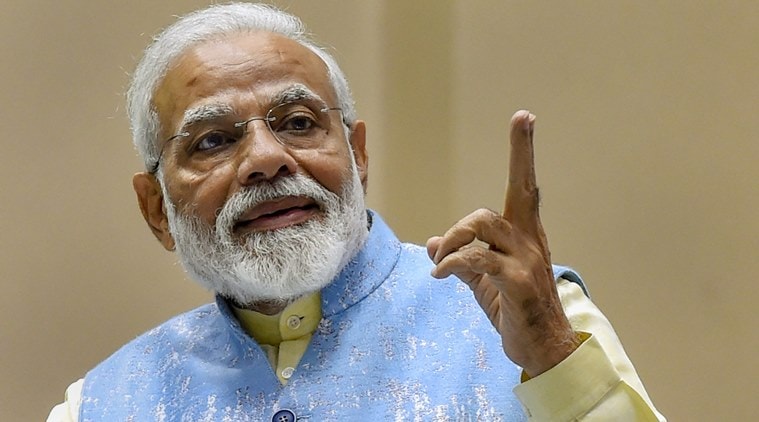The anti-national newspaper!
It is a mystery why the Prime Minister’s Office held parallel negotiations undermining the efforts of the INT. It is a mystery why the three anti-corruption clauses were deleted. It is a mystery why the payment security system was jettisoned... The facts point to an oblique purpose. The CAG had a duty to probe these mysterious aspects and bring out the truth. He failed the country.

The Rafale controversy will not go away! If it had been pushed to the background because of the Pulwama terrorist attack and the retaliatory strike by the Indian Air Force, Prime Minister Modi brought it back centre stage by his provocative remark, ‘If we had the Rafale aircraft….’
To his misfortune, within two days of his remark, The Hindu published another investigative article on the Rafale deal. The article punctured the conclusion of the Comptroller & Auditor General (CAG) that the NDA deal was cheaper than the UPA deal by 2.86 per cent. (The government’s claim that the price it had negotiated was 9-20 per cent cheaper had been rejected in the CAG’s report.)
Which deal was cheaper?
The issue is quite simple. Under the UPA deal, Dassault was required to give a bank guarantee and a performance guarantee. Under the NDA deal, that requirement was waived. While providing a guarantee the bank will charge the customer, in this case Dassault. That is the ‘cost’ of the guarantee — something that every businessman is familiar with. In the Rafale deal, since a sum of approximately Rs 60,000 crore was involved, the guarantee charges would have been stiff.
If one deal was loaded with guarantee charges and the other deal was not loaded with guarantee charges, common sense will tell us that, before the two prices are compared, the guarantee charges in the first deal should be taken out. CAG got the numbers. He calculated the charges in two parts:
The CAG used alphanumerics because he had promised the government to ‘redact’ the price information! He did the government a huge favour.
However, the CAG was forced to conclude as follows:
“Therefore, the total saving of AAB3 million € accruing to the vendor by not having to pay these Bank Charges should have been passed on to Ministry. Ministry has agreed to the Audit calculations on Bank Guarantees but contended that this was a saving to the Ministry because the Bank guarantee charges were not to be paid. However Audit noted that this was actually a saving for M/s DA when compared to its previous offer of 2007.”
CAG failed the nation
The guarantee charges remained hidden from the public and a meaningful comparison could not be made about the prices of the two deals. The Hindu story has ferreted out the information from the report of the Indian Negotiating Team (INT). The charges were € 574 million. If this amount is taken out of the UPA deal and the two deals are compared, the NDA deal is more expensive by € 246.11 million. At the current exchange rate of Rs 80, the NDA deal is more expensive by Rs 1,968 crore. On this count alone, each of the 36 aircraft will be more expensive by Rs 54.66 crore.
It is a mystery why the Prime Minister’s Office held parallel negotiations undermining the efforts of the INT. It is a mystery why the three anti-corruption clauses were deleted. It is a mystery why the payment security system — sovereign guarantee, bank guarantee and escrow account — was jettisoned. These could not have been done out of ‘love and affection’ for Dassault. The facts point to an oblique purpose. The CAG had a duty to probe these mysterious aspects and bring out the truth. He failed the country.
The Hindu is bringing out the hidden aspects of the deal one by one. And what is the government’s response? The government is accusing the newspaper of using ‘stolen documents’ and threatening to slap criminal charges! The Attorney General of India was fielded by the government to hold out these threats!
Famous stolen papers
In 2012-14, the Government of India obtained the names of account holders in Swiss banks that had been hacked and passed on to France and Germany. The Income Tax department issued notices, raised tax demands and launched prosecutions. Was the I-T department acting on the basis of ‘stolen documents’? Similarly, in 2016, 11.5 million documents were leaked from the computers of a law firm (stolen by someone?) to a German newspaper, Sueddeutsche Zeitung, which shared them with the International Consortium of Investigative Journalists. The I-T department had no qualms about releasing the names of account holders who were Indians or NRIs and issuing notices to them.
The famous Pentagon Papers were actually a secret report commissioned by the US Defense Secretary on the Vietnam war. It was leaked in 1971.
The Washington Post was preparing to publish them. The US government sued the newspapers. The US Supreme Court by a vote of 6-3 allowed The New York Times and The Washington Post to publish the documents without the risk of censorship or punishment (403 U.S. 713). Justices Black, Douglas, Brennan Jr., Stewart, White and Marshall put freedom of speech above vague concerns of national security and held that spread of information was critical to keep the democratic process intact. No one even mentioned ‘stolen documents’!
History is repeating itself, this time in India. Mr Modi and his ministers will brand The Hindu as anti-national or worse. Regardless of the invectives, readers will continue to read the newspaper. The Rafale aircraft will arrive. There will be an inquiry. The truth will be out. The life of the country will go on.






































No hay comentarios:
Publicar un comentario